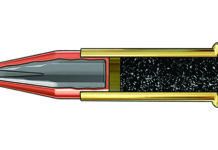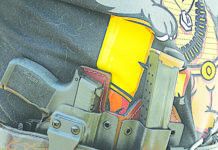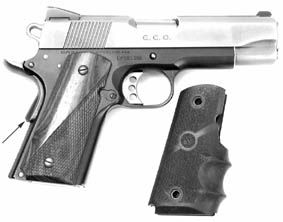
Handgun grips may be made of many diverse materials. Some are chosen for appearance, like genuine elephant or fossil ivory or finely figured wood. Others are used for economy, like plastics. Black rubber, usually sticky and soft, is commonly used in factory grips from many makers, particularly where recoil might be heavy. Wood laminates also are increasingly common, and these can be very attractive as well. The final finish on the grip can be either carved, fully or partially checkered, or left smooth. The grip can include grooves for the fingers or thumbs.
But whats the best material for self-defense handguns? This isnt so crucial a question for guns used for other purposes, since the price of having the wrong grip on a plinking, hunting, or target gun isnt a life-or-death consideration. But the gun you choose to carry needs to come into action quickly, smoothly, effortlessly, and accurately, and your connection to the gun through its grips are a prime factor in your ability to make this happen.
How does your favorite gun stack up in this crucial department?
The Basics
Before we get into material differences, lets state a few basics. The grip on your self-defense handgun must permit grasping the piece in the shooting grip before it ever leaves the holster. The grip should permit the hand to slip into position, and yet allow a good controlled grasp on the piece during presentation (drawing the piece) and under recoil. Of course, the grip shouldnt stick to your clothing or otherwise hang up because of texturing. Not only will that decrease the concealability of the weapon, it can prohibit or slow the clothing from being swept away from the pistol by the strong hand during the presentation.
No matter how many times you practice your draw, your hand wont grab the gun in exactly the same position every time-although with lots of practice youll be mighty close. This means the grip needs to permit your hand to slide the last fraction of an inch into the correct grasp. Various materials handle this job differently, as weve learned.
Rubber
New rubber grips are notorious for sticking to your clothing on the way out. We also dont like rubber grips on concealment handguns because they tend to stick to the inside of your clothing, and that can telegraph that youre carrying.
Some of rubbers shortcomings can be seen on the Colt CCO. This nearly perfect-packin-size pistol is a small, but still .45 ACP, version of the 1911, with Officers-size grip and Commander-length slide. As the gun comes from Colts, it is fitted with a one-piece rubber grip that wraps around the front of the grip strap. The rubber has finger grooves that might or might not fit your fingers. The rear edges of these original rubber grips make contact with the web of the hand during the presentation and prevent the hand from sliding into place easily. Obviously, this setup was not designed by a serious handgunner.
Rubber grips certainly have their place, and in the experience of some of our test shooters, that place is on revolvers. Rubber grips can cut felt recoil significantly. They are impervious to weather-but with todays synthetic finishes so is wood, for the most part. Most rubber grips weve seen have some sort of finger-positioning devices molded in. We believe this is done not out of necessity, but just because it is possible to do so. The manufacturers figure, Why not?, and attempt to give the buyer more for his money. In fact, unless the grip protrusions for thumb or fingers fit your hand perfectly, youre getting less for your money. Weve cut the finger grooves off several grips and vastly improved them as a result. Example: The Smith & Wesson N-framed Mountain Guns come with the thin rubber Hogue Monogrips, often with finger grooves, which can be contoured as needed.
Gun Tests Recommends
One neoprene rubber replacement grip we like is the Pachmayr Presentation Compact, a round-butt model which has no grooves and is about as small as it can be for N-framed revolvers. Its available from Brownells (No. 692-403-002) for $26.50. If your gun cant accept this grip, we nonetheless recommend it as an archetype for you to gauge other products against.
Plastic Grips
Weve got no quarrel with plastics. The pseudo-ivory types require a very close look to tell theyre not elephant teeth. A good set of plastic-ivory stocks might cost $50, where the real thing would be about $500 at todays prices. Aside from the ivory look, some very attractive and obviously synthetic patterns or colors can be formed into plastic, and if you like them, go for it. Plastics can form the background for some great scrimshaw, so if you want that type of artwork on your handgun, plastic grips might be just the ticket.
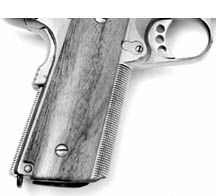
On the down side, plastic can crack or break in the cold, or from being dropped, or from being installed with too much torque on the mounting screws. Plastic feels cold, unlike wood, and if youre carrying the gun outside, that might make a big difference. Plastic is relatively inexpensive, generally looks it, and with the high cost of a good handgun today, it seems out of place to put plastic grips on it.
Gun Tests Recommends
Plastics come in many shapes, sizes and colorations, so sorting them out can be difficult. But several models (by no means exclusive) fit our requirements for easy draw. Among them are Entrprise Armss Ultra Slim Zytel grips for Para-Ordnances P13s and P14s, (Brownells Nos. 292-010-013 and 292-010-014, $29.75). Prater & Company makes various uncheckered plastic 1911 replacement grips in white pearl, black pearl, and other colors and patterns. Among the most interesting, in our view, are the ivory (Brownells No. 632-100-007), Gold Black (No. 632-100-006), and bone colors (No. 632-100-008, all $59). Ajax also makes a series of polymer grips for a variety of guns.
Wood
To solve his grip problems, the CCO owner mentioned above replaced the Colts stock rubber grips with semi-checkered wood, and eliminated the sharp bottom edge of the grip safety with a file and sandpaper. These two simple modifications gave the CCO an essentially perfect grip. Its owner considers this setup ideal for that handgun.
The CCO owner installed Kim Ahrends Tactical wood grips (in this case made of cocobolo), which have only their lower-forward portion checkered. The uncheckered upper-rear area permits the hand to slide into place easily without having to fight the checkering. As a bonus, the uncheckered area lets the attractive wood grain show up well. Once the hand grasps the pistol, the lower-forward checkered area contacts the fingers enough to give good control. Another bonus is that this semi-checkered design permits the gun to move easily as it is flipped in the hand for reloading.
Wood and laminated-wood grips today are generally finished in epoxy for ultimate durability. This permits the grain or pattern to be seen, and keeps moisture and dirt out of the wood pores. The choice of wood doesnt necessarily mean youre sacrificing strength or durability. Properly aged and finished fancy wood is one of the most attractive materials for handgun stocks, and is the first choice of many a serious pistol shooter.
There are zillions of types of wood used for handgun grips, and the good news is that most of it is perfectly suitable for the job. Fancy French or Circassian walnut is considered by many to be the finest of all grip material. It is easily worked, serves the gun well, looks great, and most varieties take and hold checkering well. Carved wood grips are sometimes seen, but ivory shows carving better than wood. Kim Ahrends lists many types of wood including bubinga, camiteo, cocobolo, cordia, ebony, kingwood, rosewood, African blackwood, bloodwood, moradillo, padauk, tulipwood, various walnuts, and on and on. Some experienced shooters feel there is nothing, even ivory, as generally satisfactory as good wood on a handgun. Even when abused the wood continues to enhance the guns looks over time. Good wood is not inexpensive, even for as common a handgun as the 1911. Exotic grades of wood for the old warhorse might go for upward of $100.
Gun Tests Recommends
There are many replacement wood grips that are beautiful, functional, and affordable. Brownells sells almost a dozen brands, with many choices per brand. A few to consider are the cocobolo Ahrends 1911 Auto Tactical , No. 052-004-104 (pin cutout, $50); the Ahrends Combat Checkered Officers ACP in rosewood, No. 052-050-207; AFS Tech 1911 Slim Tech Grip in walnut for the 1911, No. 064-100-001, $44.95; Hogues Semi-Auto Pistol Grip for the Beretta 92, the smooth Goncalo Alves wood model No. 408-603-035, and others.
Other Materials
Real ivory is a superb grip material, but its very costly today. It has a look and feel unmatched by most other materials. Once youve handled real ivory grips, youll know what we mean. It can be carved, checkered, scrimshawed, or left smooth. In any guise its a great grip material for your pistol or revolver.
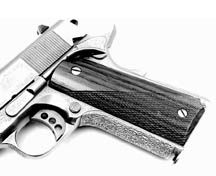
Old ivory often cracks and turns yellow, yet still manages to look good. New ivory stocks ought not to be cracked or yellowed, though some like that look.
How about stag and bone? Both of these are relatively heavy, and neither has the durability of wood under rough conditions, and can crack. Some folks really like stag, and the real thing is certainly not cheap. Its tough to tell plastic from real stag, so if you think you want stag grips you might experiment with the plastic alternatives noted above.
Mother-of-pearl comes from the insides of abalone or other shells, and is extremely hard. The real thing is not often seen today, but plastic imitations of it are common, particularly on pocket autoloaders. Mother-of-pearl is flashy and glitzy looking, and may not be for you. As Gen. Patton was fond of saying, pearl looks good on pimps guns. His own were stocked in ivory. The plastic versions are easier to find and much cheaper.
There are also synthetic woods, made from pressed-together bits and shavings or sawdust of real wood, the lot held together in an epoxy matrix. This has all the benefits of plastic but with a woody look. We dont know of anyone who much likes this material, but it is both inexpensive and durable, and also can show carving well.
Gun Tests Recommends
Because of their relative scarcity, we cant recommend specific models of real ivory, stag, bone, or mother-of-pearl grips. However, synthetic woods are readily available from Ahrends, including Dymondwood versions ($60 from Brownells) and Micarta models from Navidrex ($40 from Brownells).
Checkering
The choice of checkering on pistol grips is largely personal, as are most grip decisions, ultimately. Weve seen just about everything over the years on 1911-style pistols. On this style of handgun, the front and back strap treatment has to be weighed against what goes on the grip panels. Smooth grips with checkered front and rear straps work well for some. Most of the hand pressure comes from a squeeze from the front to the rear. If front and rear straps are checkered, the grips can be smooth.
However, be advised that nothing grabs (and destroys) the lining of a mens coat jacket more quickly than 20-lines-per-inch steel checkering. Yet nothing gives a better grasp on the pistol once that pistol is in the hand, no matter how sweaty the hand might be.
If the front and rear straps are smooth, some checkering on the side panels seems appropriate. The above-mentioned Colt CCO had a smooth front strap but a custom-checkered plastic mainspring housing in back, and the overall grip control was superb. A Wilson CQB we tested a while back had a 30-lines-per-inch front strap, with fully checkered blackwood grip panels. The wood could have been half checkered, like Ahrends Tactical grips, and perhaps been even better.
If wood checkering is too fine, it doesnt work, no matter that it looks great and speaks volumes for the skills of its maker, if its well done. If too coarse, the individual diamonds will break off and the grips will soon look shoddy.
Gun Tests Recommends
One well-known and extremely talented world-class handgunner believes the Pachmayr rubber grips to be the best design for 1911-style pistols. He doesnt like the wrap-around design, however, so he cuts the thin forward panel out and installs just the rubber side panels. However, this fellow has huge hands that permit him to reload without shifting his grip on the pistol.
The point is that each shooters needs are going to be slightly different from the next persons. However, there are some absolutes, chief among them is that your pistol must work for you.
Changing the grips on a concealment gun is fairly easy and inexpensive, but the first factor to weigh is how well do the gripping surfaces respond in your hands-big, little, oily, dry, sweaty, fat, bony, whatever. Use what you like, but be sure your grips will do what you want them to do before you stake your life on them.


























